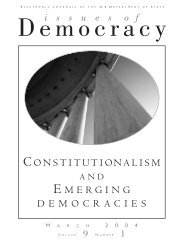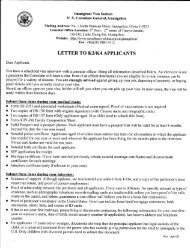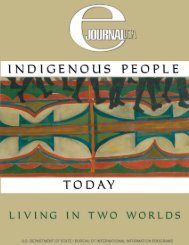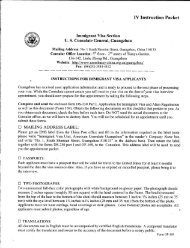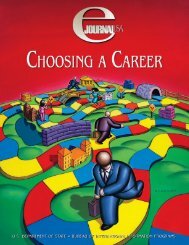s. history us history us history - Embassy of the United States
s. history us history us history - Embassy of the United States
s. history us history us history - Embassy of the United States
- No tags were found...
You also want an ePaper? Increase the reach of your titles
YUMPU automatically turns print PDFs into web optimized ePapers that Google loves.
CHAPTER 12: POSTWAR AMERICAOUTLINE OF U.S. HISTORYplained, “conservative when it comesto money, liberal when it comes tohuman beings.” A critic counteredthat Eisenhower appeared to arguethat he would “strongly recommend<strong>the</strong> building <strong>of</strong> a great many schools... but not provide <strong>the</strong> money.”Eisenhower’s first priority wasto balance <strong>the</strong> budget after years <strong>of</strong>deficits. He wanted to cut spendingand taxes and maintain <strong>the</strong> value <strong>of</strong><strong>the</strong> dollar. Republicans were willingto risk unemployment to keepinflation in check. Reluctant tostimulate <strong>the</strong> economy too much,<strong>the</strong>y saw <strong>the</strong> country suffer threeeconomic recessions in <strong>the</strong> eightyears <strong>of</strong> <strong>the</strong> Eisenhower presidency,but none was very severe.In o<strong>the</strong>r areas, <strong>the</strong> administrationtransferred control <strong>of</strong> <strong>of</strong>fshoreoil lands from <strong>the</strong> federal governmentto <strong>the</strong> states. It also favoredprivate development <strong>of</strong> electricalpower ra<strong>the</strong>r than <strong>the</strong> public approach<strong>the</strong> Democrats had initiated.In general, its orientation was sympa<strong>the</strong>ticto b<strong>us</strong>iness.Compared to Truman, Eisenhowerhad only a modest domesticprogram. When he was active inpromoting a bill, it likely was to trim<strong>the</strong> New Deal legacy a bit — as inreducing agricultural subsidies orplacing mild restrictions on laborunions. His disinclination to p<strong>us</strong>hfundamental change in ei<strong>the</strong>r directionwas in keeping with <strong>the</strong> spirit <strong>of</strong><strong>the</strong> generally prospero<strong>us</strong> Fifties. Hewas one <strong>of</strong> <strong>the</strong> few presidents wholeft <strong>of</strong>fice as popular as when heentered it.THE CULTURE OF THE 1950SDuring <strong>the</strong> 1950s, many culturalcommentators pointed outthat a sense <strong>of</strong> uniformity pervadedAmerican society. Conformity, <strong>the</strong>yasserted, was numbingly common.Though men and women had beenforced into new employment patternsduring World War II, once <strong>the</strong>war was over, traditional roles werereaffirmed. Men expected to be <strong>the</strong>breadwinners in each family; women,even when <strong>the</strong>y worked, assumed<strong>the</strong>ir proper place was at home. In hisinfluential book, The Lonely Crowd,sociologist David Riesman calledthis new society “o<strong>the</strong>r-directed,”characterized by conformity, butalso by stability. Television, still verylimited in <strong>the</strong> choices it gave its viewers,contributed to <strong>the</strong> homogenizingcultural trend by providing youngand old with a shared experience reflectingaccepted social patterns.Yet beneath this seeminglybland surface, important segments<strong>of</strong> American society see<strong>the</strong>d withrebellion. A number <strong>of</strong> writers,collectively known as <strong>the</strong> “BeatGeneration,” went out <strong>of</strong> <strong>the</strong>ir wayto challenge <strong>the</strong> patterns <strong>of</strong> respectabilityand shock <strong>the</strong> rest <strong>of</strong> <strong>the</strong>culture. Stressing spontaneity andspirituality, <strong>the</strong>y preferred intuitionover reason, Eastern mysticism overWestern institutionalized religion.The literary work <strong>of</strong> <strong>the</strong> beatsdisplayed <strong>the</strong>ir sense <strong>of</strong> alienationand quest for self-realization. JackKerouac typed his best-selling novelOn <strong>the</strong> Road on a 75-meter roll <strong>of</strong>paper. Lacking traditional punctuationand paragraph structure, <strong>the</strong>book glorified <strong>the</strong> possibilities <strong>of</strong> <strong>the</strong>free life. Poet Allen Ginsberg gainedsimilar notoriety for his poem“Howl,” a scathing critique <strong>of</strong> modern,mechanized civilization. Whenpolice charged that it was obsceneand seized <strong>the</strong> published version,Ginsberg successfully challenged <strong>the</strong>ruling in court.M<strong>us</strong>icians and artists rebelled aswell. Tennessee singer Elvis Presleywas <strong>the</strong> most successful <strong>of</strong> severalwhite performers who popularizeda sensual and pulsating style <strong>of</strong> African-Americanm<strong>us</strong>ic, which beganto be called “rock and roll.” At first,he outraged middle-class Americanswith his ducktail haircut and undulatinghips. But in a few years hisperformances would seem relativelytame alongside <strong>the</strong> antics <strong>of</strong> laterperformances such as <strong>the</strong> BritishRolling Stones. Similarly, it was in<strong>the</strong> 1950s that painters like JacksonPollock discarded easels and laid outgigantic canvases on <strong>the</strong> floor, <strong>the</strong>napplied paint, sand, and o<strong>the</strong>r materialsin wild splashes <strong>of</strong> color. All <strong>of</strong><strong>the</strong>se artists and authors, whatever<strong>the</strong> medium, provided models for<strong>the</strong> wider and more deeply felt socialrevolution <strong>of</strong> <strong>the</strong> 1960s.ORIGINS OF THE CIVILRIGHTS MOVEMENTAfrican Americans became increasinglyrestive in <strong>the</strong> postwaryears. During <strong>the</strong> war <strong>the</strong>y had challengeddiscrimination in <strong>the</strong> militaryservices and in <strong>the</strong> work force,and <strong>the</strong>y had made limited gains.Millions <strong>of</strong> African Americans hadleft Sou<strong>the</strong>rn farms for Nor<strong>the</strong>rncities, where <strong>the</strong>y hoped to findbetter jobs. They found insteadcrowded conditions in urban slums.Now, African-American servicemenreturned home, many intent on rejectingsecond-class citizenship.Jackie Robinson dramatized <strong>the</strong>racial question in 1947 when hebroke baseball’s color line and beganplaying in <strong>the</strong> major leagues. Amember <strong>of</strong> <strong>the</strong> Brooklyn Dodgers,he <strong>of</strong>ten faced trouble with opponentsand teammates as well. Butan outstanding first season led tohis acceptance and eased <strong>the</strong> wayfor o<strong>the</strong>r African-American players,who now left <strong>the</strong> Negro leagues towhich <strong>the</strong>y had been confined.Government <strong>of</strong>ficials, and manyo<strong>the</strong>r Americans, discovered <strong>the</strong>connection between racial problemsand Cold War politics. As <strong>the</strong> leader<strong>of</strong> <strong>the</strong> free world, <strong>the</strong> <strong>United</strong> <strong>States</strong>sought support in Africa and Asia.Discrimination at home impeded<strong>the</strong> effort to win friends in o<strong>the</strong>rparts <strong>of</strong> <strong>the</strong> world.Harry Truman supported <strong>the</strong>early civil rights movement. He personallybelieved in political equality,though not in social equality, andrecognized <strong>the</strong> growing importance<strong>of</strong> <strong>the</strong> African-American urban vote.When apprised in 1946 <strong>of</strong> a spate <strong>of</strong>lynchings and anti-black violencein <strong>the</strong> South, he appointed a committeeon civil rights to investigatediscrimination. Its report, To Secure270271



